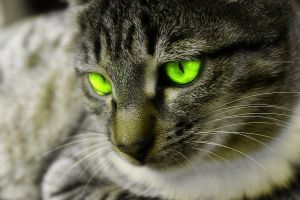It was impossible to tell how old the male cat was as he inched toward the bowls of food. Most feral cats won’t allow themselves to be touched. However, years of cat rescue work told us the Burmese we dubbed “Bobby” was probably at least 10. He walked slowly and avoided strolling along the fence like most of the younger feral cats. Odd behavioral signs soon appeared. Since we couldn’t pick him up, there was no way to get Bobby to a vet to potentially diagnose and treat senility in this cat.
Overview
The signs of senility in a cat who’s a senior – one who’s at least 12 – are usually very different from those in human beings. Vets label senility in cats cognitive dysfunction. The terms are interchangeable.
Cat senility is linked to behavioral changes most owners don’t associate with cognitive problems. In fact, according to CatHealth.com, most people tend to think of aging as a disease when it’s really just a natural progression of a cat’s life. Senility is unfortunately sometimes part of this progression.
The first sign most owners note is the loss of playfulness common to a kitten or very young cat. The symptoms of senility in cats are really a collection of behaviors owners find peculiar in their pets. Among the most common are loss of bowel or bladder control, increased time sleeping, loss or coordination and a change of disposition leaning toward irritability and aggression, PetPlace.com reports.
Some cats cry excessively and experience separation distress at night. Decreased grooming, disorientation, wandering and loss of appetite are also typical.
Diagnosis
Veterinarians make a diagnosis of senility in cats by relying on groups of symptoms that point to this condition rather than a single type of strange behavior. A diagnosis is the result of determining whether the signs in a senior cat indicate an inclination toward senility, then ruling out conditions that have the same symptoms.
Among other conditions that produce many of the symptoms of feline cognitive dysfunction are brain tumors and intestinal bacterial or parasites. Inflammatory conditions of the brain and surrounding membranes as well as others like rabies, toxoplasmosis and brain abscesses must be ruled out. Other problems that cause similar symptoms are hyperthyroidism, dietary issues such as thiamine deficiency, kidney and liver failure and lead poisoning.
In addition to conducting a thorough physical exam and taking a medical history, vets exclude many potential culprits by using lab tests and imaging such as CT or MRI scans. When there is no other reasonable explanation for the cat’s behavioral changes, the diagnosis is senility.
Treatment
Once a senior cat has been diagnosed as senile, therapy starts immediately. The only treatment known to result in significant benefits is the drug deprenyl (brand name: Anipryl). While it’s only licensed to treat cognitive dysfunction in dogs, vets are permitted to use it to treat cats as well.
Vets typically administer this drug in cats as a low oral dose once a day followed by an evaluation of the cat’s response after two to four weeks. PetPlace.com suggests that if there is no apparent benefit and no side effects, the dose should gradually increase until either the cat appears to improve or side effects mandate no higher dosage.
A positive response is usually a full or partial return to the cat’s former activity level and more typical behavior. However, it’s important to realize that the medication is only treating symptoms and not the underlying process, which is linked to the cat’s aging.
Home care for cats with senility is extremely important. Owners should be vigilant about recording symptoms of odd behavior and should keep the cat in familiar surroundings. All cats at least 12 years old should receive senior cat exams by a vet at least twice a year.
This condition doesn’t require caregivers who have particular medical expertise. However, it does require patience with all the steps required to diagnose and treat senility in cats and the ability to stay calm when troubling changes in behavior occur.
Sources:
http://www.cathealth.com/goldenyears.htm
http://www.petplace.com/cats/cognitive-dysfunction/page1.aspx?utm_source=catcrazynews001et&utm;_medium=email&utm;_content=petplace_article&utm;_campaign=dailynewsletter






